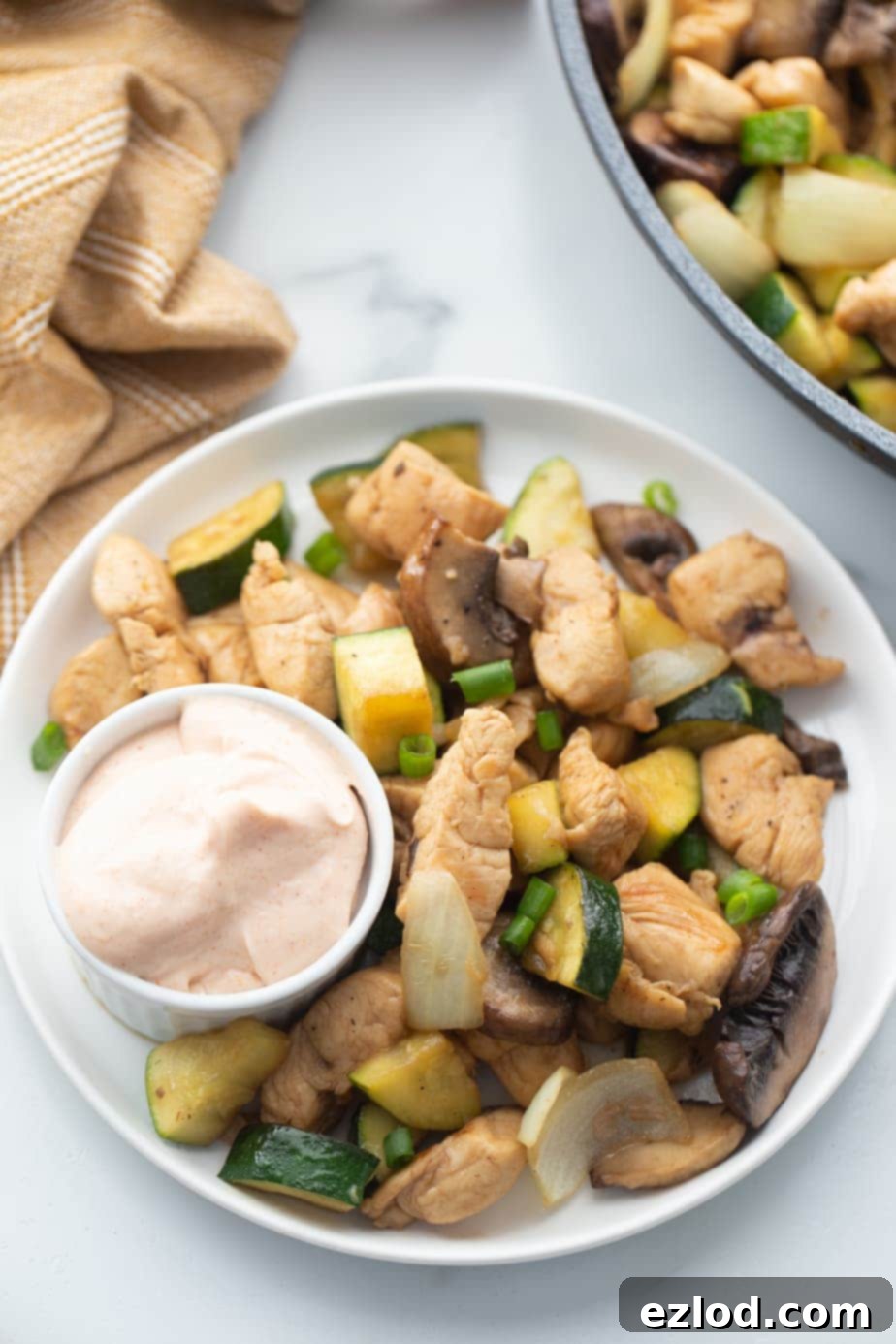Homemade Hibachi Chicken Recipe: Healthy, Easy, and Delicious with Yum Yum Sauce
Hibachi Chicken offers a burst of savory flavor that makes for an incredibly easy and satisfying dinner the whole family will adore. Inspired by my daughter’s absolute favorite Japanese steakhouse meal, this homemade Hibachi Chicken recipe brings all the deliciousness of restaurant-style hibachi right into your kitchen. What’s even better? It’s significantly healthier, more budget-friendly, and comes together in 30 minutes or less! Plus, we’ve included a fantastic homemade Yum Yum sauce recipe for that essential creamy, tangy dip that completes the experience. Get ready to transform your weeknights with this delightful and healthy meal!
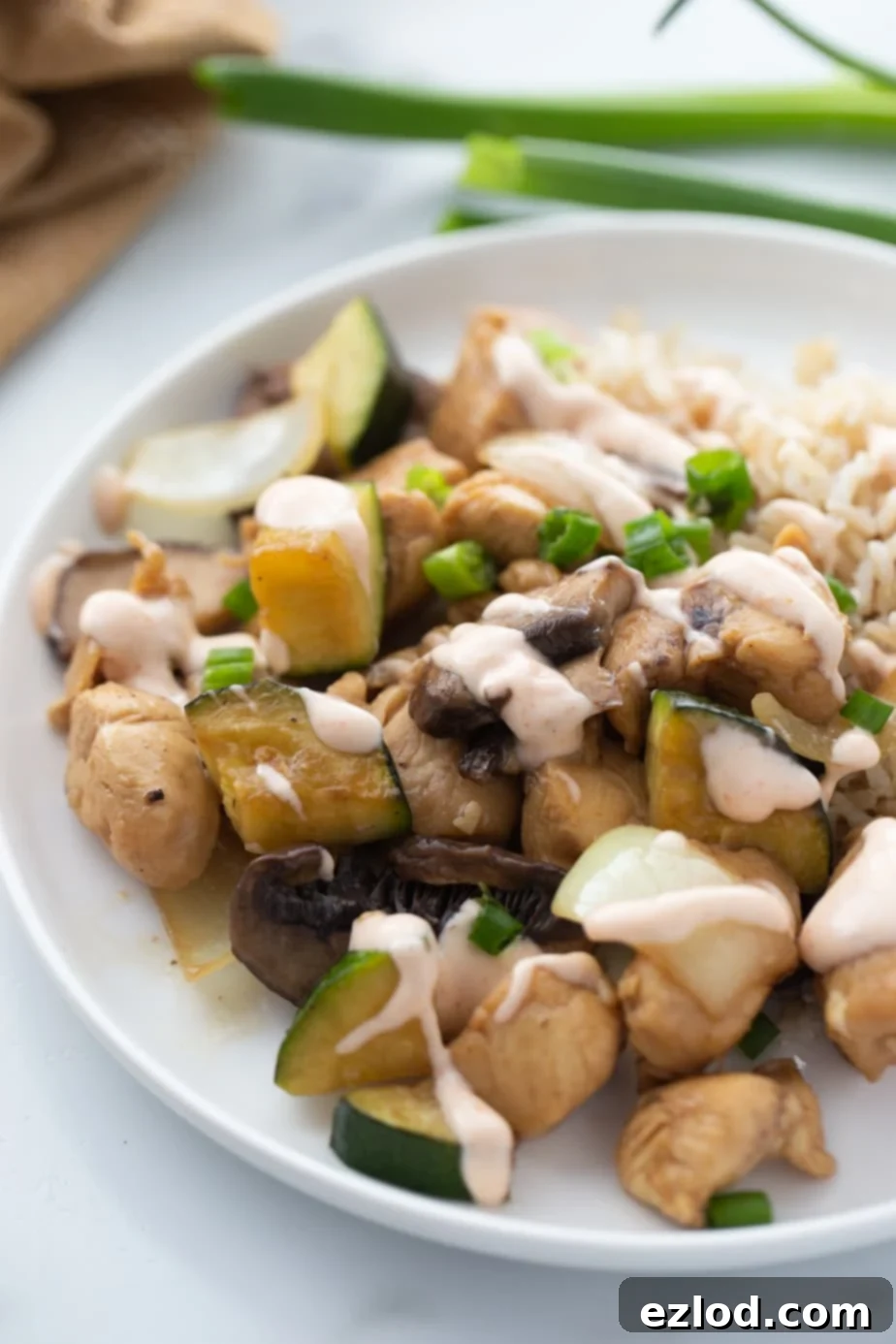
This heartwarming homemade hibachi chicken recipe carries a special significance for our family, particularly for my daughter’s upcoming birthday. Hibachi chicken isn’t just one of her favorite meals; it’s actually the dish that finally convinced her to love zucchini – a true parenting win! Preparing this meal at home has become a cherished tradition, especially after an unexpected turn of events last year.
Thinking back to her birthday last year, it brings a bit of anxiety as it coincided with a dramatic shift in the world. We had plans for a special birthday dinner at her favorite hibachi restaurant, followed by a party with ten of her closest friends. As you can imagine, everything was canceled overnight.
While I know these were minor inconveniences in the grand scheme of things, and we were incredibly fortunate to have our health, my “momma heart” still aches when I recall the disappointment on her face when I broke the news. Yet, true to her amazing spirit, she handled it with grace and resilience. Here we are, one year later, about to celebrate her 11th birthday (how time flies!). There won’t be a big party again this year, but we will certainly celebrate in all the ways that truly matter. And, without a doubt, this copycat Benihana Hibachi Chicken recipe will be the star of our birthday menu!
Our goal with this recipe is to take the beloved typical hibachi meal and transform it into a healthier, more economical version without sacrificing any of that incredible taste – especially the magic of that homemade yum yum sauce. It’s about bringing restaurant-quality flavor and fun to your dinner table, affordably and healthily.
New! If you love this recipe, you must also try our equally delicious Hibachi Steak and this Healthy Hibachi Fried Rice! They make perfect companions to this chicken dish or fantastic meals on their own.
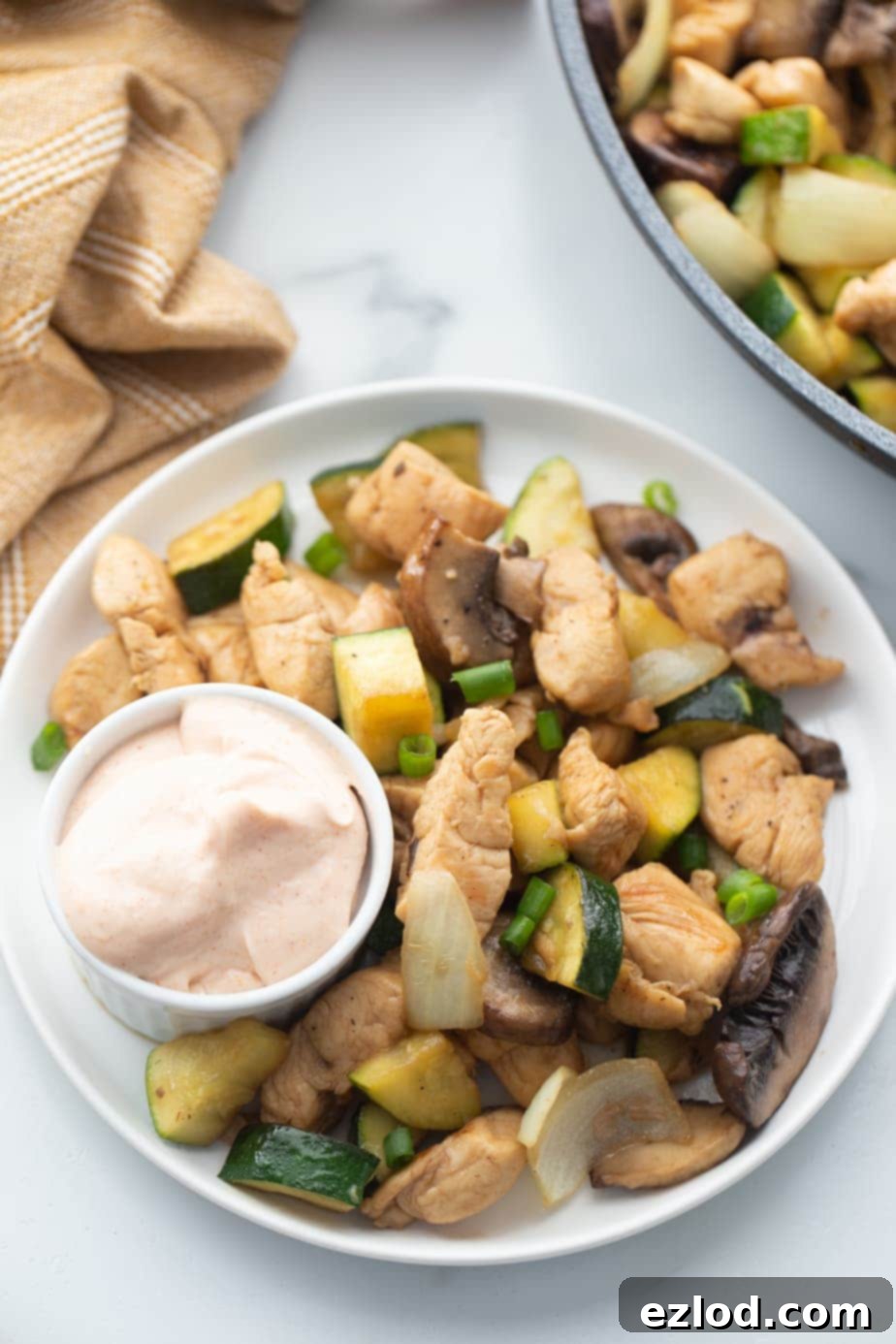
Table of Contents
Toggle
Why This Homemade Hibachi Chicken Recipe Rocks
There are countless reasons why this homemade hibachi chicken has quickly become a steadfast family favorite, gracing our dinner table regularly. It’s more than just a meal; it’s an experience that offers convenience, nutrition, and incredible flavor all in one:
- A Beloved Family Staple: This recipe has truly captured our hearts over the past year, and I’m thrilled to finally share it with you. It’s a dish everyone enthusiastically requests, making meal planning a breeze.
- Restaurant Quality at Home: You don’t need a professional hibachi chef or a special teppanyaki grill to enjoy the authentic flavors of a Japanese steakhouse. With this easy weeknight dinner, you can recreate that delicious taste right in your own kitchen using standard equipment like a large skillet or wok. No special showmanship required (unless you feel inspired to put on one yourself!).
- A Healthier Twist on a Classic: While it boasts the familiar, mouth-watering taste of traditional hibachi, my version is thoughtfully crafted to be much healthier. We use lean, tender chicken breast and a vibrant medley of fresh hibachi vegetables like vitamin-rich mushrooms and zucchini. This entree is naturally packed with essential nutrients and lean protein, making it a wholesome choice you can feel great about serving.
- Irresistible Homemade Yum Yum Sauce: Ask my husband, and he’ll tell you the homemade Yum Yum sauce is his absolute favorite part! Made with wholesome, natural ingredients, this creamy, slightly sweet, and tangy sauce is seriously addictive. You’ll love generously drizzling it over (or deeply dipping) your hibachi chicken and veggies. It’s a game-changer!
- Quick & Easy Preparation: Life gets busy, which is why a recipe that delivers big flavor in minimal time is a winner. This hibachi chicken dinner is designed for speed and simplicity, making it perfect for busy weeknights when you still want a nutritious and delicious meal without a long cooking process.
- Budget-Friendly: Enjoying hibachi at a restaurant can be pricey, especially for a family. Making it at home saves you a significant amount of money, allowing you to indulge in this delightful cuisine more often.
Key Ingredients + Easy Substitutions
Crafting the perfect hibachi chicken involves a few key fresh ingredients. Here’s what you’ll need, along with some helpful substitution ideas to make this recipe your own:
- Chicken Breasts: We prefer boneless, skinless chicken breasts for their lean protein and quick cooking time. Chicken tenderloins are also an excellent option. For high-quality, organic, free-range chicken, I often source mine from Butcher Box.
- Substitution: Feel free to switch up the protein! This recipe is incredibly versatile and equally delicious with steak (such as sirloin or ribeye, cut into bite-sized pieces), shrimp, or even a delightful combo of chicken and shrimp for a surf and turf experience.
- Olive Oil: Used for sautéing the chicken and vegetables.
- Substitution: Avocado oil is another fantastic choice, offering a neutral flavor and high smoke point, making it ideal for high-heat cooking.
- Sesame Oil: This ingredient is crucial for that authentic hibachi flavor. Beyond taste, it’s also a healthy fat that adds depth.
- Tip: Use toasted sesame oil for a more intense flavor.
- Butter: A touch of butter adds richness and helps with caramelization, enhancing the overall flavor.
- Substitution: Use unsalted butter to better control the sodium content, or opt for dairy-free butter or ghee if you follow a dairy-free, Paleo, or Whole30 diet.
- Onion: Adds a foundational savory note to the dish.
- Recommendation: White or yellow onions work best for their sweet and pungent balance when cooked.
- Baby Bella Mushrooms: These provide a wonderful umami flavor and meaty texture, plus they’re rich in B vitamins.
- Substitution: If mushrooms aren’t your preference, you can easily swap them for other favorite veggies like sugar snap peas, broccoli florets, sliced red bell peppers, or even bok choy.
- Zucchini: A low-calorie and nutrient-dense vegetable, especially rich in Vitamin A.
- Substitution: Similar to mushrooms, feel free to substitute zucchini with other quick-cooking vegetables such as thinly sliced carrots, green beans, or asparagus.
- Garlic: An incredibly flavorful and aromatic ingredient that’s also low in calories.
- Tip: If you’re a garlic lover, don’t hesitate to toss in an extra clove or two, or a dash of garlic powder for a concentrated flavor boost.
- Coconut Aminos: This is my go-to healthy alternative to soy sauce. It’s naturally gluten-free, soy-free, and has a lower sodium content, with a slightly sweeter, milder flavor profile that works beautifully in Asian-inspired dishes.
- Substitution: If you don’t have coconut aminos, you can use low-sodium tamari (for gluten-free) or regular low-sodium soy sauce.
- Lemon Juice: An optional but highly recommended addition that brightens the flavors of the chicken and vegetables, adding a natural zest.
- Salt and Pepper: Simple seasonings are all you need to bring out the natural deliciousness of these fresh ingredients.
- Recommendation: A sprinkle of Himalayan pink salt and a crack of fresh black pepper are perfect.
- Garnish (Optional): For an extra layer of flavor and visual appeal, feel free to garnish your finished dish with sliced green onions (scallions) and a sprinkle of sesame seeds. (My kids aren’t big fans, but adults often love it!)
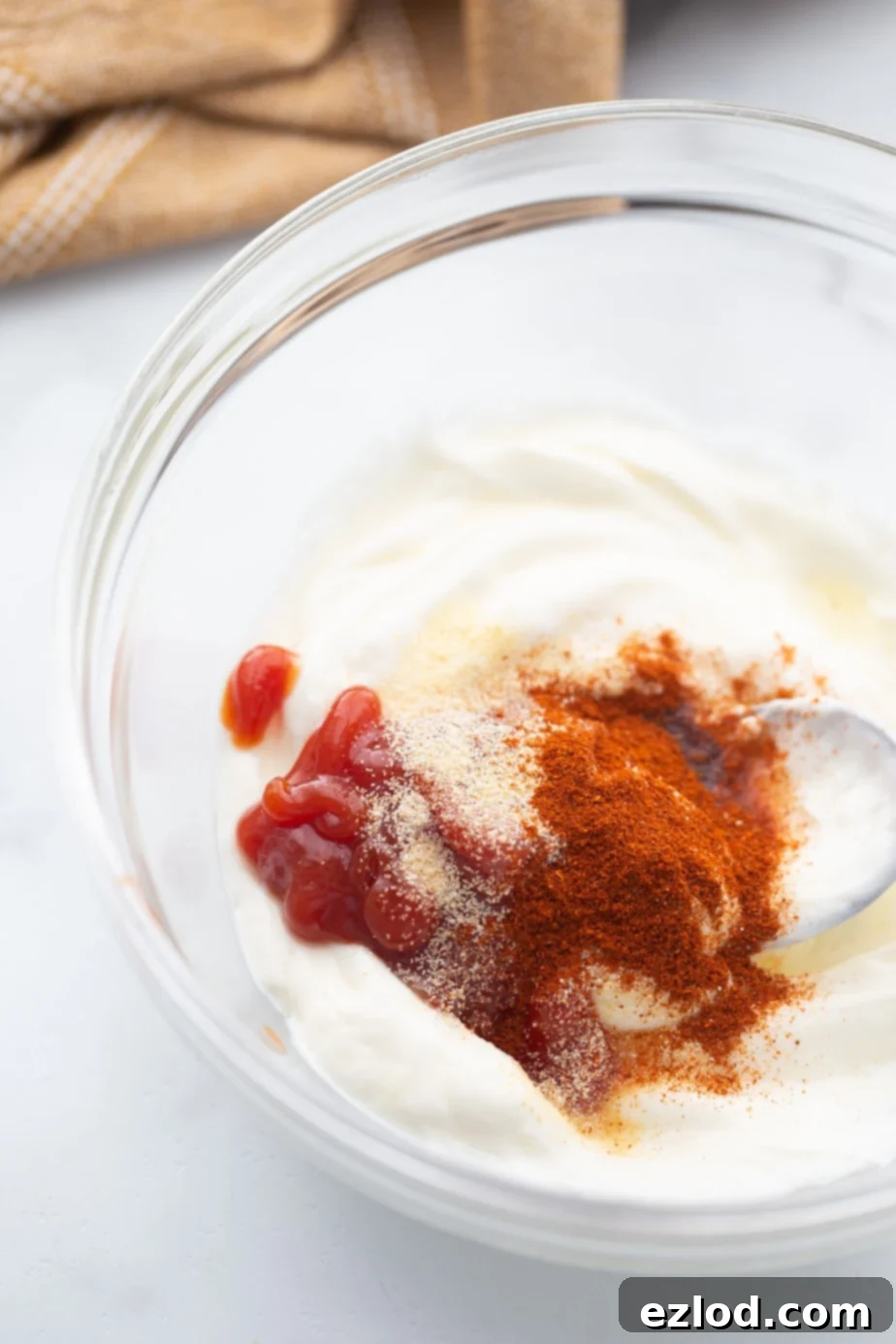
What is Yum Yum Sauce?
If you’ve never had Yum Yum sauce, sometimes affectionately called “white sauce” or “shrimp sauce,” you are truly missing out on a culinary delight! This iconic, creamy pinkish-orange sauce is a staple at Japanese hibachi restaurants, served generously alongside shrimp, steak, and chicken, and sometimes even rice or noodles. Its unique blend of savory, sweet, and tangy flavors makes it incredibly versatile and universally loved.
While I’m also a big fan of ginger sauce and plan to share that recipe on the blog soon, a poll on Instagram revealed that you, my readers, absolutely LOVE your Yum Yum Sauce. So, I prioritized bringing you a healthier, homemade version that captures all the deliciousness without any artificial ingredients or excessive sugar. It’s the perfect sweet and savory condiment for any hibachi-style meal you prepare at home, elevating every bite to pure bliss!
Ingredients for Homemade Yum Yum Sauce
Creating this irresistible homemade Yum Yum sauce is surprisingly simple, requiring just a few common pantry staples. Here’s what you’ll need to whip up this creamy, flavorful dip:
- Mayonnaise: The creamy base of our sauce.
- Recommendation: Regular mayonnaise or olive oil mayo both work perfectly. For a healthier option, consider using avocado oil mayonnaise.
- Ketchup: Adds a touch of sweetness and that signature pinkish hue.
- Tip: Use a naturally sweetened ketchup to avoid a lot of added sugar, making this dish more “FIX approved” if you’re following a specific meal plan. If you’re adhering to a Paleo or Whole30 diet, be sure to use a compatible ketchup.
- Butter: A small amount of melted butter contributes to the sauce’s rich, smooth texture and flavor.
- Substitution: Dairy-free butter or ghee can be used for those avoiding dairy.
- Rice or Apple Cider Vinegar: Provides the essential tangy kick that balances the sweetness and creaminess.
- Choice: Rice vinegar is more traditional for Japanese-inspired sauces, but apple cider vinegar will yield a similarly delicious result if that’s what you have on hand.
- Paprika: This seasoning is key for giving the sauce its beautiful reddish-orange color, as well as a subtle, smoky flavor.
- Tip: Smoked paprika can add an extra layer of depth.
- Garlic Powder: A crucial flavor enhancer that perfectly complements the paprika and adds a savory depth.
- Tip: Adjust to your taste – a little goes a long way!
- Salt: Just a pinch is all you need to emphasize and round out all the other delightful flavors in this sauce.
Equipment You Will Need
You don’t need fancy hibachi grills to make this recipe a success! Here’s the basic kitchen equipment that will make preparing this dish a breeze:
- Large Skillet or Wok: A heavy-duty skillet or wok is essential for cooking the chicken and vegetables efficiently at medium-high heat. A cast iron skillet also works wonderfully for achieving a nice sear.
- Sharp Knife and Cutting Board: For dicing your chicken and chopping all those fresh vegetables.
- Mixing Bowl: For whisking together your homemade Yum Yum Sauce.
- Whisk or Fork: To combine the sauce ingredients until smooth.
- Measuring Cups and Spoons: For accurate ingredient measurement.
- Spatula or Tongs: For stirring and flipping ingredients in the skillet.
- Meat Thermometer: Highly recommended to ensure your chicken is cooked to a safe internal temperature of 165°F (74°C).
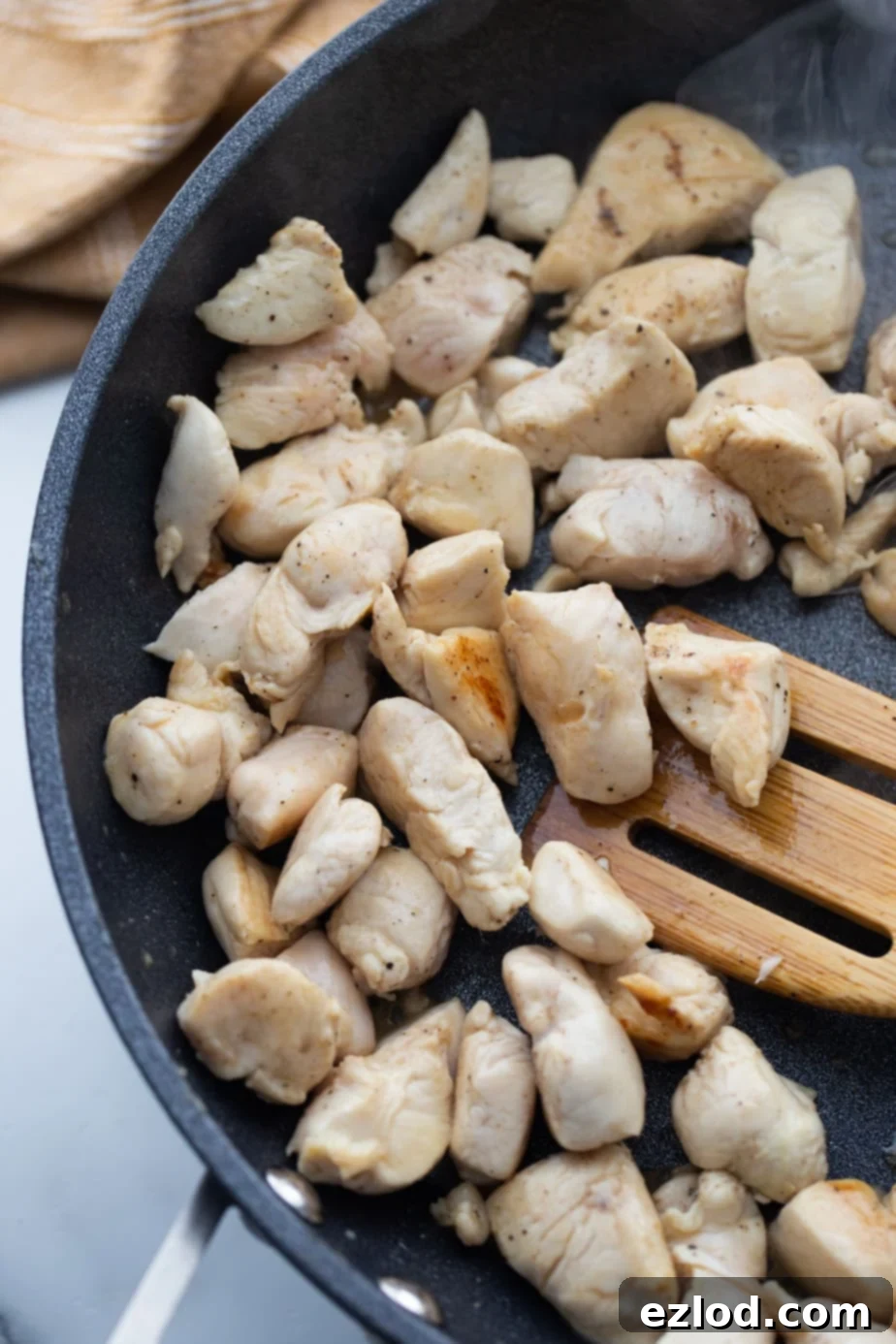
Detailed Step-by-Step Instructions
Follow these easy steps to create your mouthwatering homemade hibachi chicken and vegetables:
- Prepare the Yum Yum Sauce: In a small bowl, whisk together all the ingredients for the Yum Yum sauce until completely smooth. Once mixed, cover the bowl and place it in the refrigerator to chill. This allows the flavors to meld beautifully, creating a more cohesive and delicious sauce. You can even make this sauce a day ahead for convenience!
- Prep Your Ingredients: Before you start cooking, ensure all your chicken and vegetables are diced into bite-sized pieces. Hibachi cooking is fast, so having everything prepped and ready (mise en place) will make the process smooth and enjoyable.
- Cook the Chicken: Heat a heavy-duty skillet or wok over medium-high heat. Add 1 teaspoon of olive oil and ½ teaspoon of sesame oil. Once the oil is shimmering, add the diced chicken pieces and the optional lemon juice. Cook the chicken, stirring occasionally, until it’s no longer pink and has reached an internal temperature of 165°F (74°C). This usually takes about 5-7 minutes depending on the size of your chicken pieces.
- Flavor the Chicken: In the last minute of the chicken’s cook time, add 1 tablespoon of butter and 3 tablespoons of coconut aminos to the skillet. Stir well, allowing the sauce to coat the chicken and slightly thicken. This step infuses the chicken with rich, savory, and slightly sweet notes. Once coated and cooked through, remove the chicken and its delicious sauce from the pan and set it aside to keep warm.
- Sauté the Vegetables: Using the same skillet (no need to clean it – those browned bits add flavor!), add the remaining 1 teaspoon of olive oil and ½ teaspoon of sesame oil. Increase the heat back to medium-high. Add your prepared vegetables (onions, mushrooms, zucchini) to the hot skillet and sprinkle them with salt and pepper.
- Caramelize Veggies and Add Aromatics: Cook the vegetables, stirring frequently, until they are beautifully caramelized and tender-crisp. This usually takes about 5-8 minutes, depending on your preferred texture. In the last minute or so of cook time, add the minced garlic, the remaining 1 tablespoon of butter, and ½ teaspoon of coconut aminos. Stir constantly for about 30-60 seconds until fragrant, being careful not to burn the garlic.
- Combine and Serve: Add the cooked chicken and its reserved sauce back into the skillet with the sautéed vegetables. Give everything a good stir to combine all the delicious flavors. If you have picky eaters, you can serve the chicken and vegetables separately. Serve immediately with the chilled Yum Yum sauce and any desired side dishes, like rice or noodles. Enjoy your homemade hibachi feast!
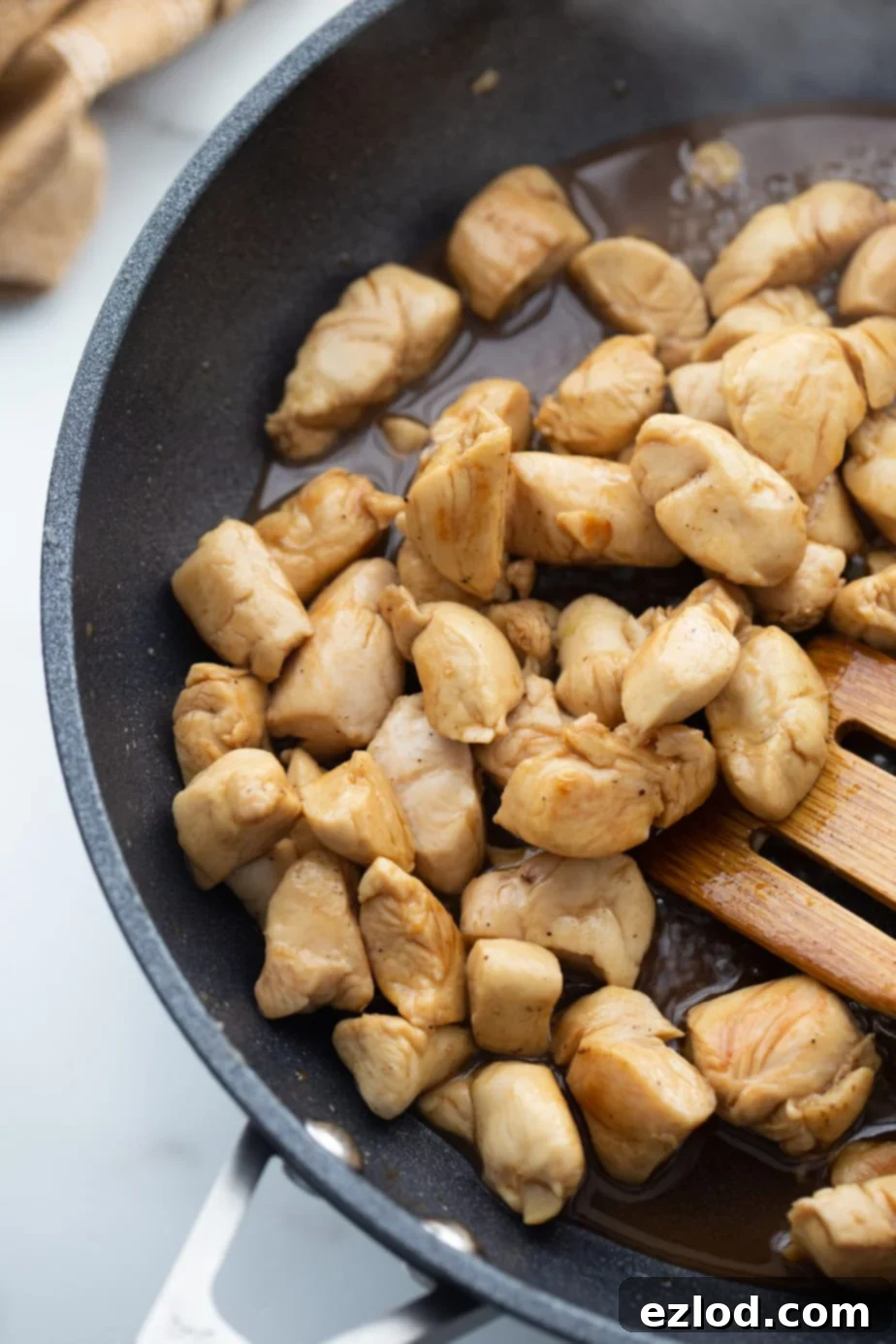
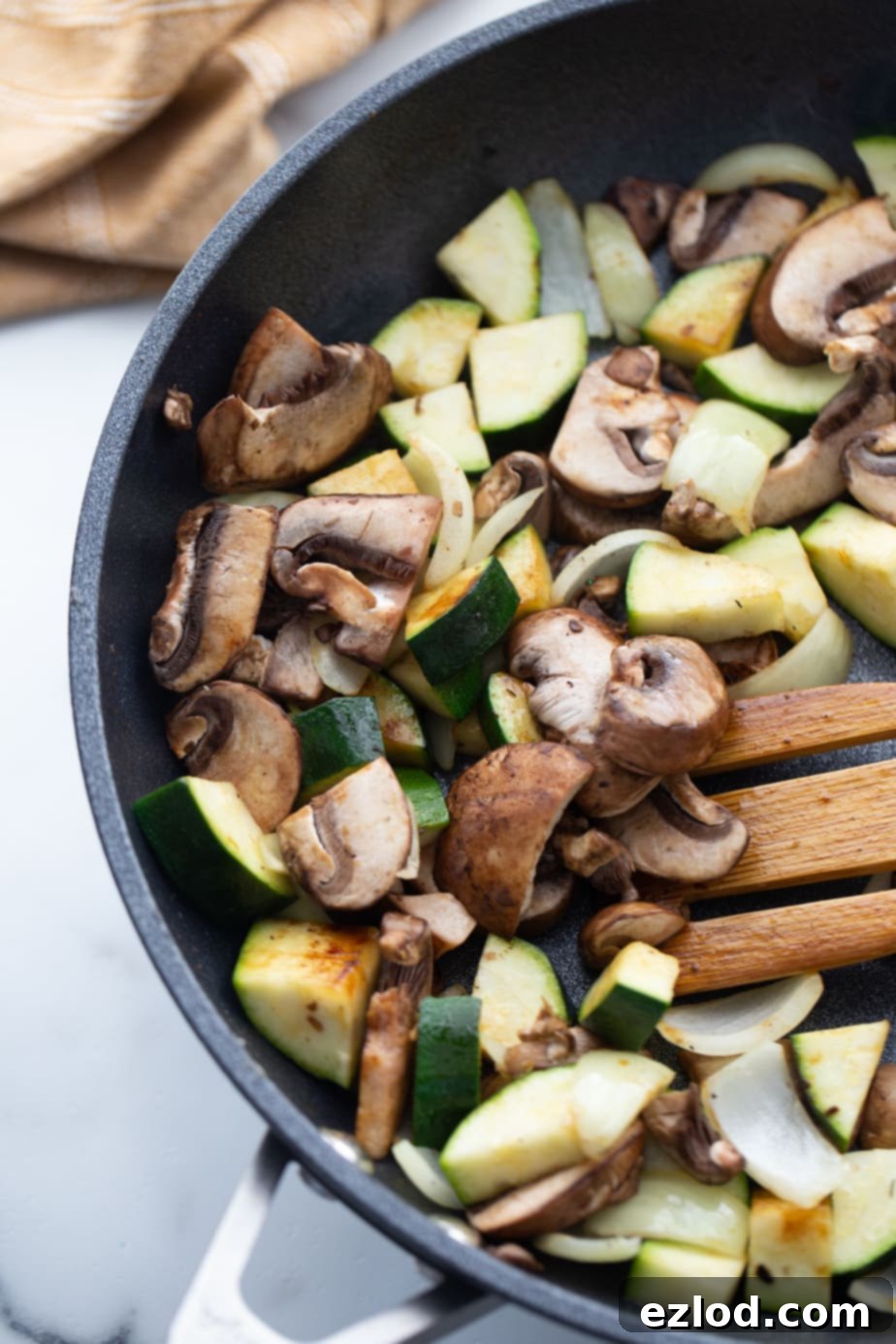
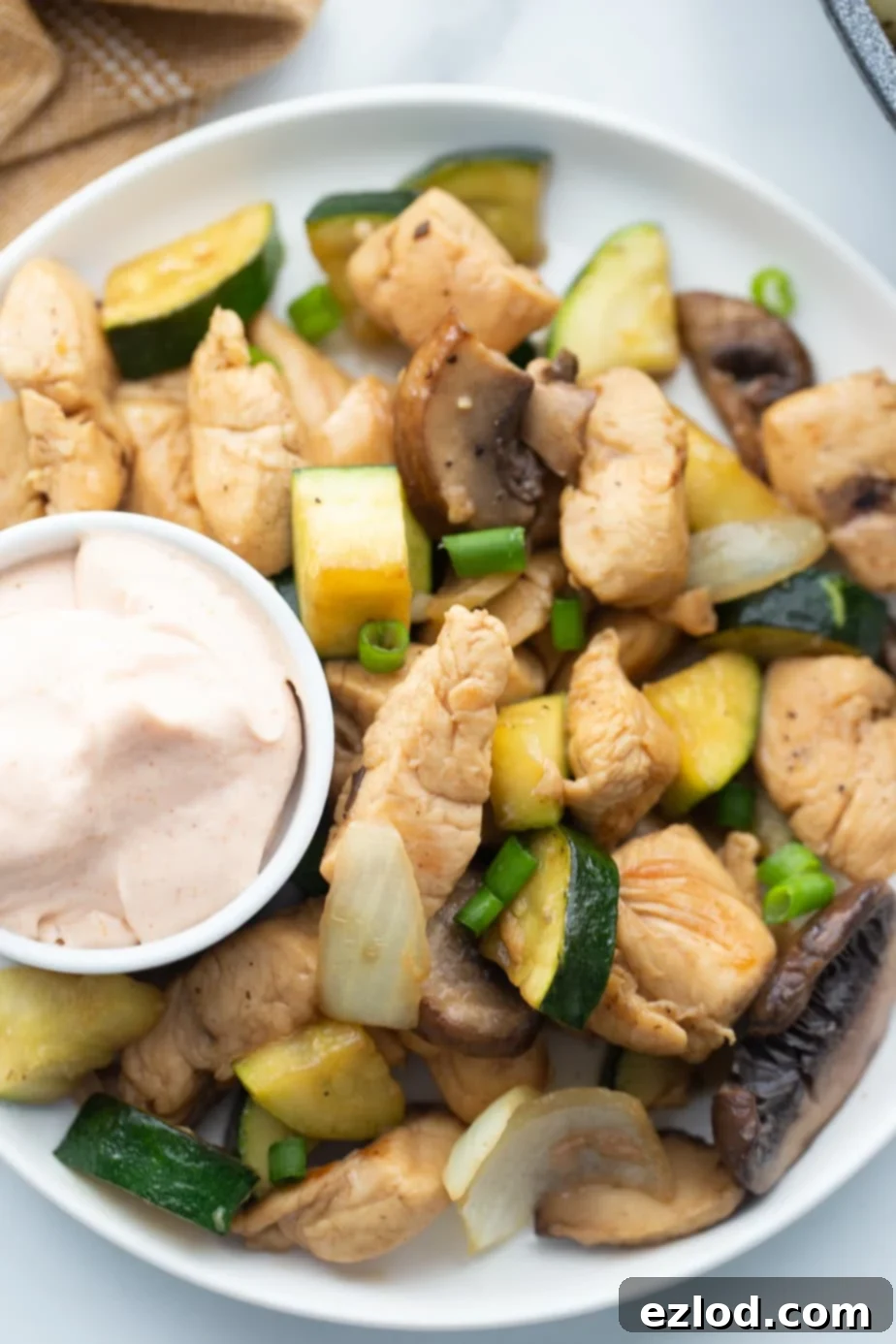
Expert Hibachi Chicken Dinner Tips for Success
To ensure your homemade hibachi chicken turns out perfectly every time, keep these helpful tips in mind:
- Choose the Right Pan: Since most of us don’t have a large hibachi grill at home, a heavy-duty non-stick skillet, a large cast iron skillet, or a wok works perfectly on the stovetop. If you do have a Blackstone griddle or a large electric griddle, it’s an excellent way to cook this dish, mimicking the restaurant experience with ease.
- Achieve Even Cooking: Cut your chicken and vegetables into uniform, bite-sized pieces. This ensures everything cooks evenly and at the same rate, preventing some pieces from being overcooked while others are undercooked.
- Don’t Overcrowd the Pan: Cook the chicken and vegetables in batches if necessary, especially if you’re using a smaller skillet or making a larger quantity. Overcrowding the pan lowers the temperature and steams the ingredients instead of searing them, preventing that desirable caramelization and browning.
- High Heat is Key: Hibachi cooking is all about high heat and quick cooking. Make sure your pan is properly preheated before adding ingredients to get that beautiful sear and tender-crisp texture.
- Customize Your Veggies: Don’t limit yourself to just mushrooms and zucchini! Feel free to incorporate other favorites like broccoli florets, sliced carrots, snap peas, bell peppers, or even asparagus. Adjust cooking times based on the density of the vegetables.
- Taste and Adjust Seasoning: Always taste your chicken and vegetables before serving and adjust salt and pepper as needed. You can also add a little more coconut aminos if you desire more savory depth.
- Spice It Up: If you enjoy a kick, add a dash of sriracha, a pinch of red pepper flakes, or a few drops of your favorite hot sauce to the chicken while it cooks or to your Yum Yum sauce.
- Meal Prep Friendly: This recipe is fantastic for meal prep! Cook a larger batch and portion it into airtight containers for quick and healthy lunches throughout the week.
- Serving Style: While some hibachi restaurants serve courses separately, we like to mix the chicken and veggies together for a complete, flavorful bite. Serve it how your family enjoys it most!
If you’re looking for a delightful way to enjoy the flavors of hibachi without breaking the bank or derailing your healthy eating goals, then this easy hibachi chicken recipe is an absolute must-try!
Recipe FAQs
When stored in an airtight container in the refrigerator, this delicious meal will remain fresh for up to 4 days. When you’re ready to enjoy your leftovers, I recommend reheating the food on the stovetop in a skillet for a few minutes to restore its texture and warmth. This makes it perfect for quick lunches, though honestly, we rarely have leftovers around here!
Absolutely! If you want to kick things up a notch by adding some extra heat, try mixing a teaspoon of sriracha or a pinch of crushed red pepper flakes into the sauce mixture while cooking, or directly into your Yum Yum sauce. You could also drizzle a hot sauce like Sriracha directly on top of your finished meal.
Yes, you can definitely use soy sauce if coconut aminos aren’t available. However, keep in mind that traditional soy sauce contains soy and gluten. For a gluten-free and soy-free option that’s closest to coconut aminos, tamari or a certified gluten-free soy sauce would be a better swap. Always look for low sodium versions of soy sauce or tamari whenever possible to better control the salt content of your dish.
Boneless, skinless chicken breasts or chicken tenderloins are generally preferred for hibachi-style cooking. They cook quickly and absorb flavors well. Chicken thighs can also be used if you prefer a richer flavor and slightly more tender texture, just ensure they are boneless and skinless and cut into uniform pieces.
While fresh vegetables are highly recommended for the best texture and flavor, you can use frozen mixed stir-fry vegetables in a pinch. Just be aware that frozen vegetables might release more water, which can make it harder to achieve good caramelization. Thaw them thoroughly and pat them dry before cooking for best results, and cook them on slightly higher heat to evaporate excess moisture.
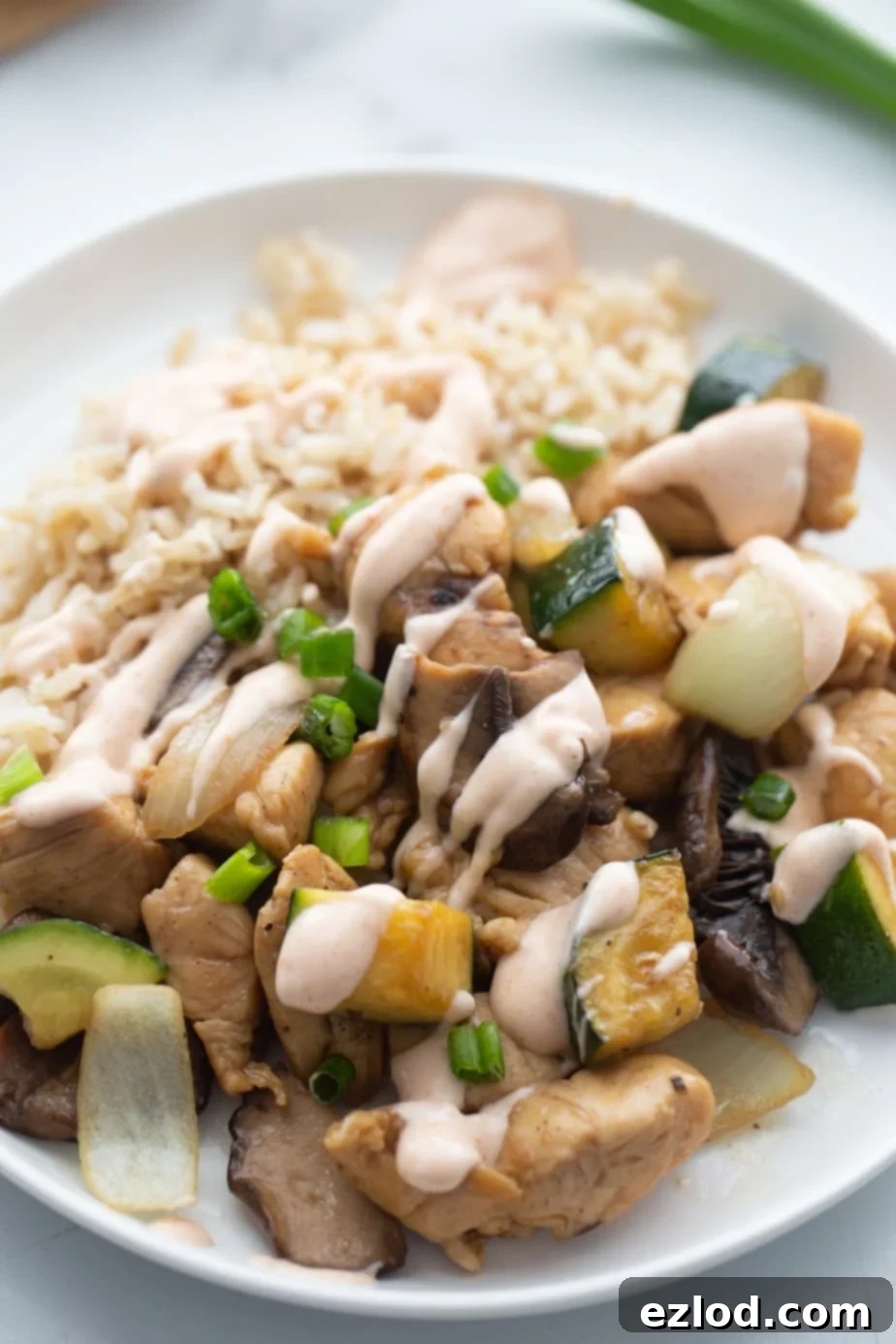
What to Serve with Homemade Hibachi Chicken
A delicious hibachi meal isn’t complete without the perfect side dishes. Here are some fantastic options to serve alongside your homemade hibachi chicken:
- Rice:
- Brown Rice: I frequently make Brown Rice in my Instant Pot; it’s a healthy and convenient option.
- Quinoa: For another high-protein, whole-grain alternative, Quinoa is always a delicious choice.
- Fried Rice: Elevate your meal with our flavorful Healthy Hibachi Fried Rice. It’s a perfect pairing that really brings the restaurant experience home.
- White Rice: Simple steamed white rice is always a classic and comforting option.
- Cauliflower Rice: For a low-carb version, serve your hibachi chicken with Cauliflower Rice. It absorbs all the delicious flavors beautifully.
- Noodles: If you prefer noodles over rice, opt for gluten-free or whole wheat noodles, or a light ramen stir-fry.
- Side Salad: A simple green salad with a light ginger dressing can add a refreshing contrast to the rich flavors of the hibachi.
- Miso Soup: For a true Japanese restaurant experience, start your meal with a warm bowl of miso soup.
Storage and Reheating Tips
This hibachi chicken recipe is fantastic for meal prepping, ensuring you have delicious, healthy meals ready to go throughout the week. Here’s how to store and reheat your leftovers:
- Refrigerator Storage: Simply place your cooked hibachi chicken and vegetables in an airtight container in the refrigerator. It will stay fresh and delicious for 3-5 days.
- Freezer Storage: For longer storage, this dish freezes wonderfully. Allow the chicken and veggies to cool completely, then transfer them to a freezer-safe ziplock bag or an airtight container. It can be frozen for up to three months.
- Thawing: To thaw, simply transfer the frozen chicken and veggies to the refrigerator overnight.
- Reheating:
- Stovetop (Recommended): For the best texture and flavor, reheat the chicken and vegetables in a well-oiled pan (like your original skillet) over low-medium heat. Stir occasionally until thoroughly heated through. This method helps prevent the chicken from drying out and allows the flavors to revitalize.
- Microwave: If you’re short on time, you can reheat portions in the microwave. Place the chicken and veggies in a microwave-safe dish, cover, and heat in 1-minute intervals, stirring in between, until hot. Be careful not to overcook, as this can make the chicken tough.
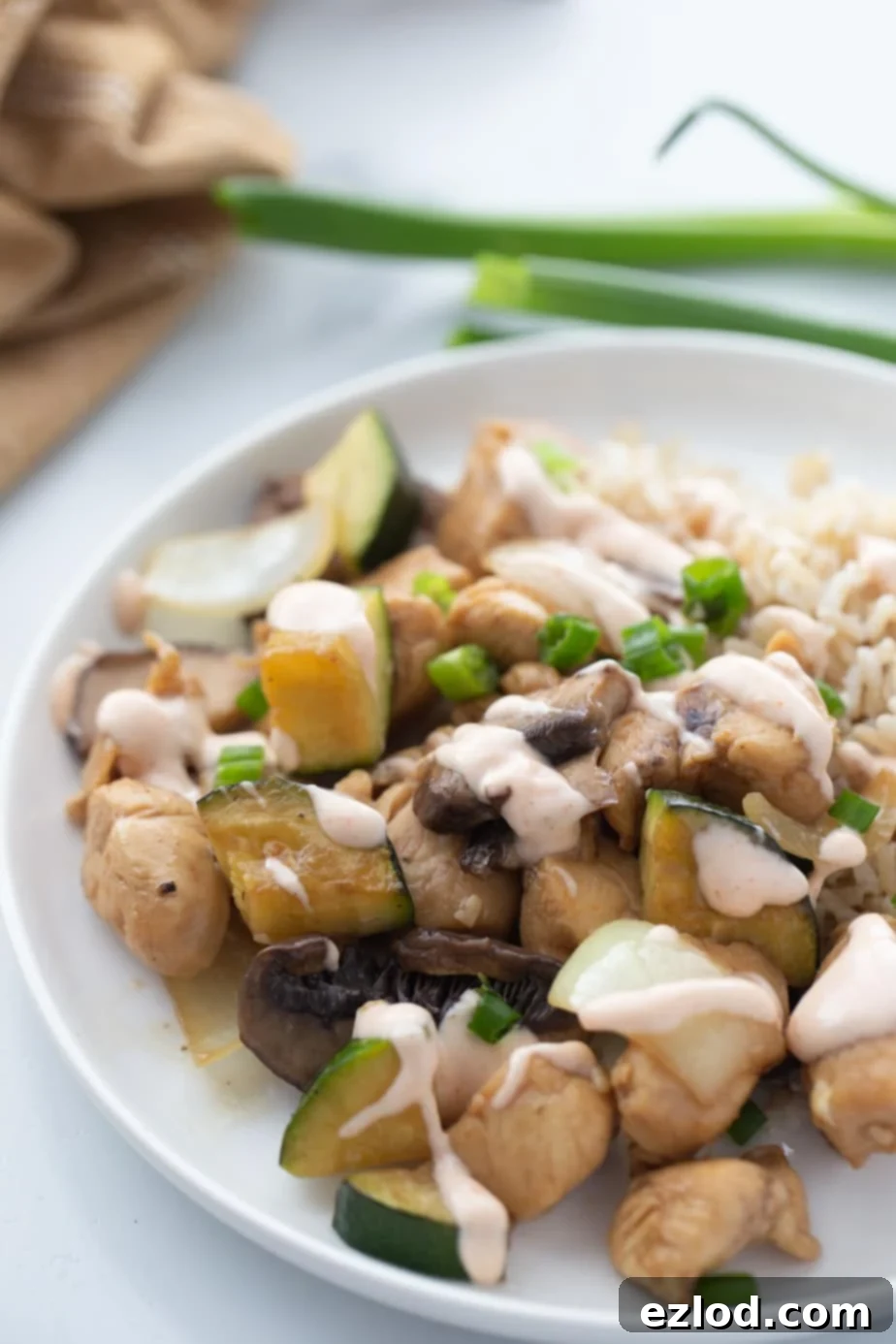
Looking for more healthy copycat recipes? Check these out:
Healthy Homemade Hibachi Steak
Healthy Chicken Lettuce Wraps | PF Changs Copycat
Healthy Chicken Ramen Noodle Stir Fry
Instant Pot Beef and Broccoli
Instant Pot Ramen Noodles | Gluten Free Ramen Noodles
Instant Pot Chicken and Broccoli
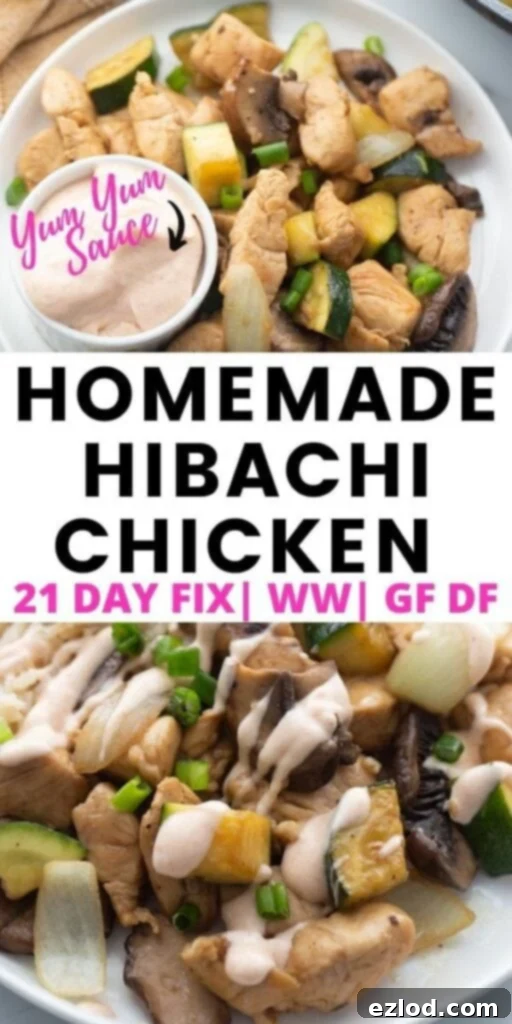
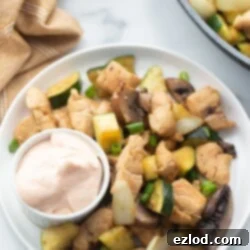
Homemade Hibachi Chicken with Yum Yum Sauce
Nancylynn
4 servings
Pin Recipe
15 minutes
15 minutes
30 minutes
Ingredients
For the Chicken and Veggies
- 1 1/2 lb Chicken tenderloins or breasts (I loveButcher Box Chicken) diced and seasoned with salt and pepper
- 2 tsp olive oil divided use
- 1 tsp sesame oil divided use
- 2 tablespoon butter divided use
- 1/4 large onion or ½ small cut into thick slices
- 2 cups (8oz) baby bella mushrooms sliced
- 2 cups (about 1 large or 2 small) zucchini chopped
- 2 cloves garlic minced
- 3 ½ tablespoon coconut aminos divided use
- 1 tsp lemon juice optional
- salt
- pepper
Yum Yum Sauce
- 1/2 cup Mayo
- 4 tsp naturally sweetened ketchup
- 1 tsp rice or apple cider vinegar
- 1 tsp butter melted
- 1/2 – 1 tsp paprika
- 1/2- 1 tsp garlic powder
- sprinkle of salt
Instructions
-
Prep your yum yum sauce by mixing all the ingredients together, then placing your sauce in the fridge to chill and allow the flavors to meld together.
-
Be sure you have your chicken and veggies diced before starting as this meal cooks quickly!
-
Heat a pan or wok over medium high heat and add 1 tsp of olive oil, and ½ tsp of sesame oil. Add in diced chicken and lemon juice (if you have it) and cook until no longer pink.
-
In the last minute or so of cook time, add in 1 Tbsp of butter and 3 Tbsp of coconut aminos. Allow sauce to thicken a bit, then remove chicken and sauce from the pan and set aside to keep warm.
-
In the same pan, add in the remaining 1 tsp of olive oil and ½ teaspoon of sesame oil and set to medium high heat. Sprinkle veggies with salt and pepper. Cook until they are caramelized and tender, adding in garlic, 1 Tbsp butter and ½ tsp coconut aminos for the last minute of cooktime.
-
You can add the chicken into your veggies at this point, or if you have picky eaters, then serve the chicken and veggies separate.
-
Serve with Yum Yum sauce or your favorite dipping sauce.
Video
Notes
21 Day Fix: 1 RED, 1 GREEN, 2 TSP, 1 ORANGE (per serving) [Orange is the yum yum sauce. If you don’t use it, don’t count the orange container]
WW: Chicken – 5 points (per serving); Yum yum sauce – 7 points (per serving) [Calculated using butter]
Nutrition
Calories: 515kcal
Carbohydrates: 9g
Protein: 39g
Fat: 35g
Saturated Fat: 9g
Polyunsaturated Fat: 14g
Monounsaturated Fat: 10g
Cholesterol: 138mg
Sodium: 734mg
Potassium: 1009mg
Fiber: 1g
Sugar: 3g
Vitamin A: 769IU
Vitamin C: 15mg
Calcium: 36mg
Iron: 1mg
Tried this Recipe? Tag me Today!Tag @confessionsofafitfoodie on Instagram and hashtag it #confessionsofafitfoodie!
